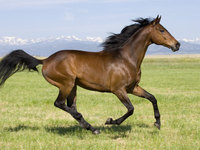A horse’s neck has a natural curve through the vertebrae. This assists him with the range of activities he must do with his neck from galloping to grazing. The curvature in his neck vertebrae are there for optimal movement and shock absorption. However, riders are often taught that a horse must learn to adapt his neck carriage to learn to use his back properly and better carry a rider. Observationally, I have noticed that most horses prefer not to change their natural head and neck carriage when under saddle, but continue to travel in the state they adopt when loose in the pasture.
Unless a horse has truly unusual anatomy or wears some sort of tack that he braces against such as the tie downs used by rodeo competitors, it is rare for a horse to develop a “ewe neck.” However, some people have the idea that if a horse is not ridden “long and low” or “collected,” he will not develop his neck muscles properly.
Horses naturally travel with their neck raised. Some individual horses have higher or lower neck sets, depending on their anatomy. We are taught in dressage circles that the nuchal ligament which goes from the base of the skull and ties into the withers should be utilized to help the horse lift the withers. Without this, he supposedly will not able to round and lift his back so he can carry a rider with more ease and less injury. We are taught that if a horse does not arch his neck he will hollow his back and be unable to bring his hind legs underneath himself for impulsion and collection.
I see lots of different anatomy in horses. It has been my observation that young dressage horses that are untrained tend to carry themselves in almost the same manner as the well developed ones. It only makes sense: if you want a horse to be competitive in dressage, you choose one with the right anatomy and movement to hopefully help the horse succeed. Warmblood horses pass tests to check for correct movement and physical features.
Many of the “baroque” breeds such as Lipizzaners have thick, cresty necks and an uphill build so they look especially beautiful when performing dressage movements. However, they rarely have the correct conformation to get to higher levels because most were not specifically bred for overly extravagant movement.

There is a lot of careful training involved in bringing along a competitive dressage horse. However, to ascribe all the lovely movement to the training and to say that the horse was “taught” to collect and move this way is not accurate. I’ve seen young horses and free horses that have not been taught exhibiting beautiful movement that the trainers later took credit for teaching to the horse.
Other trainers say the training enhances what the horse performs naturally, which I believe is more correct. They say any horse can benefit from dressage training, yet I believe many of the popular practices such as rollkur or long and low training do not actually benefit horses.
Studies have shown significant calcification in dressage horses where the nuchal ligament ties into the skull. It appears that both the practice of rollkur and making horses travel long and low puts undue pressure on the base of the neck, causing damage and eventually calcification. Obviously pain goes along with this at some point in the development of the calcification.
That these practices could cause damage makes sense to me, because horses do not carry themselves with either hyperflexion of the neck or with the neck held long and low for long periods of time when they are left to their own devices. They may adopt either position for a short period of time, but they do not keep it up long term.
As well, studies show that even horses with years of training and experience demonstrate more stress as more pressure is placed on the bit. Horses in a study would actually avoid getting treats if it meant they had to reach into bit pressure. So “accepting” the bit actually means the horse is accepting stress but it is still hard on the horse’s body, as stress hormones such as cortisol are released.
I’ve ridden a young Friesian, a couple of mustangs with little or no formal training, and some other naturally uphill built horses that felt very round underneath the rider’s seat, balanced with little effort from the rider, and offered a round, collected canter at the outset. None of this was due to training, bit acceptance, or learning collection.
I’ve also ridden some very downhill horses. Despite the fact that they didn’t move in as aesthetically pleasing a manner as some of the horses pictured above, they also were often very athletic, had no difficulty bringing their hind end underneath their body for propulsion and did not exhibit sore backs or have issues with carrying a rider such as lameness.

There are many horses such as these that are hard working and athletic. There are also many riders out there trying to get these horses to round up, arch their necks and look more “collected” because they have been taught that otherwise their horse is not using his body correctly.

Horses can hold their necks high, stick their noses out or up in the air and at the same time bring their hind end underneath, round the back, carry a rider and perform all sorts of athletic maneuvers.
It is training that teaches a horse to travel straight, to use the energy of his body, and to understand that a push from the hind leg is to govern his movement in the direction his nose is pointing. It is not teaching the horse to bend his neck in one direction or another that is crucial, but teaching him to keep his body moving in a chosen direction and at a chosen speed.
I have been on horses that arch their necks over beautifully, seem to accept the bit, push through the hind end and also bull through cues and feel dull and unresponsive. I have been on horses that give their necks easily to both sides (sometimes called “suppling”) and yet run forward with their neck turned so they can look you in the eye while they are bolting and spooking. I’ve also been on horses that carry their necks high, their noses pushed out, and they are soft, responsive, can do immediate lead changes, perfect circles, and quick transitions.
Horses can as easily carry themselves and do athletic maneuvers on a loose rein as they can when they are “on the bit.” I believe bits are a communication tool and not a balancing tool. Horses do not need to have a rider holding hard on the reins to balance at a fast gallop, and they don’t need to have a rider forcing their neck into an arch in order to do an extended trot, a collected canter, or flying lead changes.
Look at how the above horse is traveling and see if you see a hollow back or any loss of impulsion due to his head and neck carriage.
Does it seem as if the above horse would somehow connect his hind end through his body if he were to stretch his head and neck out or have a rider pull his neck over into an arch? Would it lift his withers and round his back? Or does he just travel like this because he has a long neck and long back, low neck tie in, and steep shoulder?
